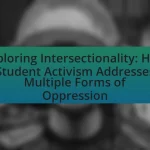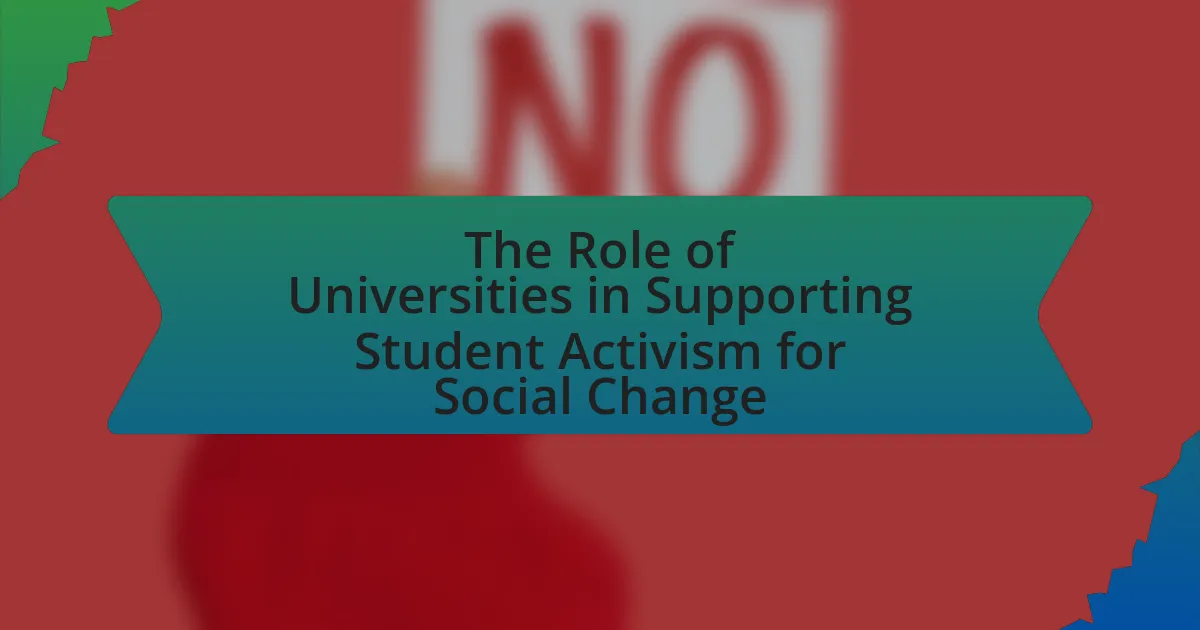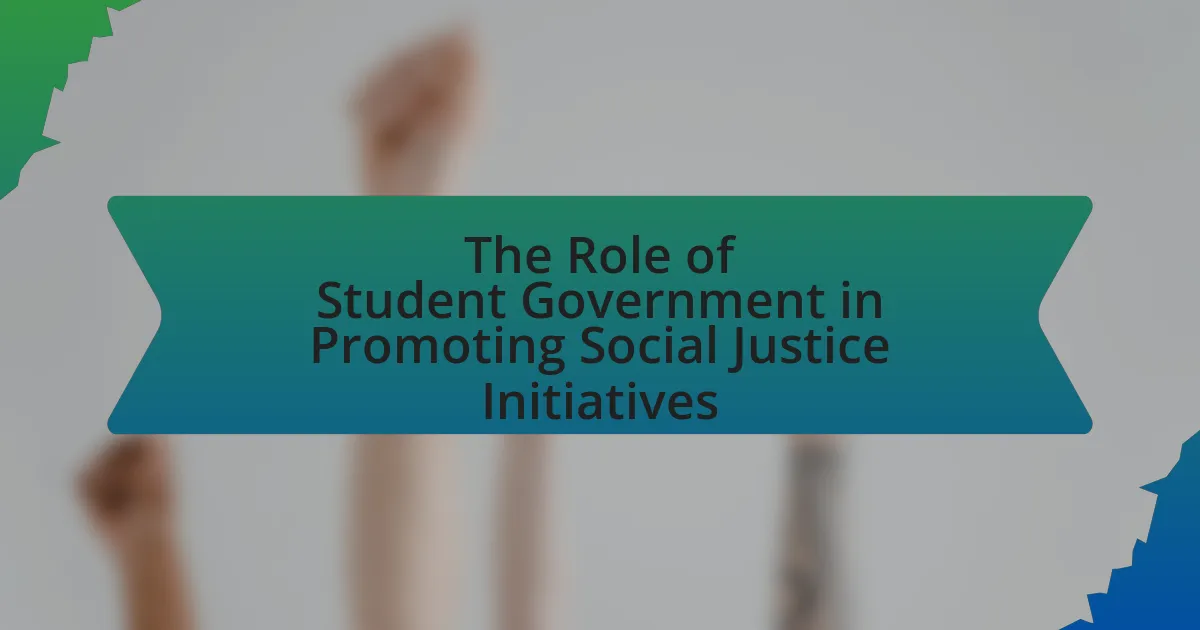A Comprehensive Social Justice Curriculum for Students is an educational framework aimed at fostering awareness and action on social justice issues, including equity, diversity, and systemic inequalities. This curriculum differs from traditional approaches by emphasizing critical analysis and inclusivity, promoting civic engagement and critical thinking among students. Key principles include equity, cultural relevance, and social action, with core components such as critical consciousness and action-oriented learning. The article outlines effective strategies for implementing this curriculum, the importance of community involvement, and best practices for sustaining its relevance in educational settings. Additionally, it discusses the role of student voices in curriculum development and the resources available to educators.
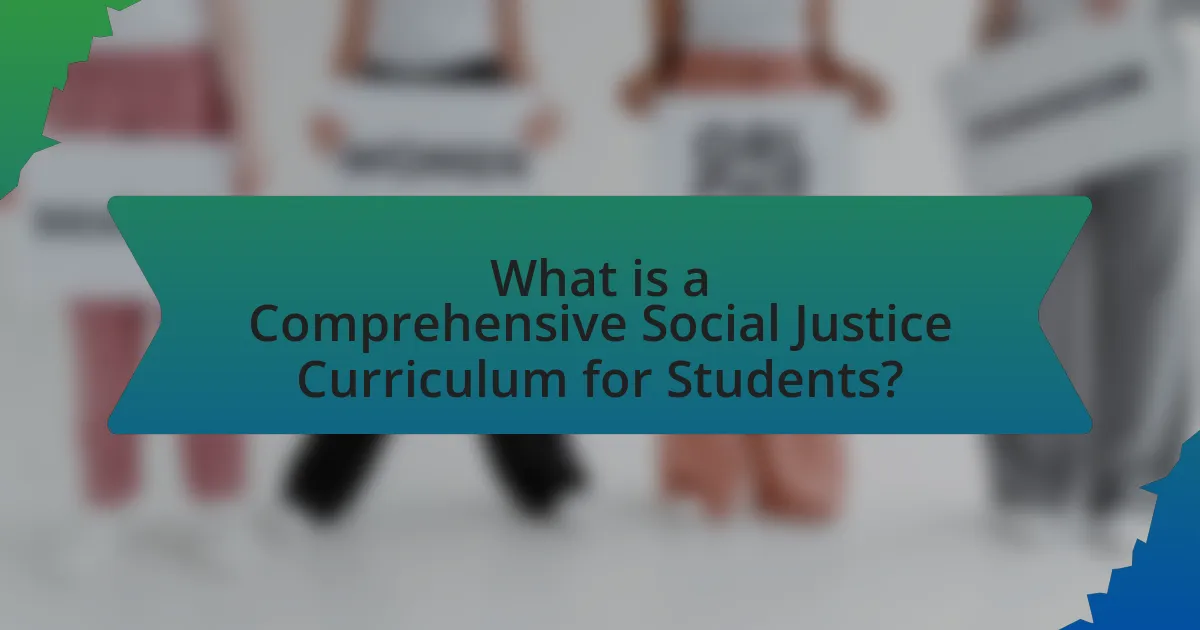
What is a Comprehensive Social Justice Curriculum for Students?
A Comprehensive Social Justice Curriculum for Students is an educational framework designed to promote awareness, understanding, and action regarding social justice issues. This curriculum typically includes topics such as equity, diversity, human rights, and systemic inequalities, aiming to empower students to critically analyze societal structures and advocate for change. Research indicates that such curricula can enhance students’ civic engagement and critical thinking skills, as evidenced by studies showing improved student outcomes in social awareness and activism when exposed to social justice education.
How does a Social Justice Curriculum differ from traditional curricula?
A Social Justice Curriculum differs from traditional curricula by prioritizing equity, inclusion, and critical analysis of societal structures. Traditional curricula often focus on standardized content delivery and rote memorization, whereas a Social Justice Curriculum emphasizes understanding systemic inequalities, fostering empathy, and encouraging active participation in social change. Research indicates that such curricula can enhance students’ critical thinking skills and civic engagement, as evidenced by studies showing improved student outcomes in schools that implement social justice principles, such as the work by the National Education Association which highlights the positive impact of culturally relevant pedagogy on student achievement.
What key principles define a Social Justice Curriculum?
A Social Justice Curriculum is defined by key principles such as equity, inclusivity, critical consciousness, and social action. Equity ensures that all students have access to the same educational opportunities, regardless of their background. Inclusivity involves recognizing and valuing diverse perspectives and experiences within the classroom. Critical consciousness encourages students to analyze social, political, and economic inequalities, fostering an understanding of systemic injustices. Social action empowers students to engage in activism and advocacy, applying their knowledge to effect change in their communities. These principles collectively aim to create a learning environment that promotes justice and equality for all students.
How does cultural relevance play a role in this curriculum?
Cultural relevance plays a crucial role in this curriculum by ensuring that the content reflects the diverse backgrounds and experiences of all students. This approach fosters engagement and promotes a sense of belonging, which is essential for effective learning. Research indicates that culturally relevant pedagogy enhances student achievement and motivation, as it connects academic material to students’ cultural contexts. For instance, a study by Ladson-Billings (1994) highlights that students perform better when they see their identities and experiences represented in the curriculum. Thus, integrating cultural relevance not only enriches the educational experience but also supports social justice by validating and affirming the identities of all learners.
Why is a Social Justice Curriculum important for students?
A Social Justice Curriculum is important for students because it fosters critical thinking and awareness of social inequalities. This curriculum equips students with the knowledge and skills to understand systemic issues such as racism, sexism, and economic disparity, which are prevalent in society. Research indicates that students exposed to social justice education demonstrate increased empathy and a greater commitment to civic engagement, as shown in a study by the National Education Association, which found that 85% of students felt more empowered to advocate for change after participating in social justice programs. By integrating these concepts into education, students are better prepared to contribute positively to a diverse and democratic society.
What impact does it have on student engagement and learning?
A comprehensive social justice curriculum significantly enhances student engagement and learning by fostering critical thinking and promoting inclusivity. This curriculum encourages students to explore diverse perspectives, which leads to increased motivation and participation in discussions. Research indicates that when students connect their learning to real-world issues, such as social justice, they demonstrate higher levels of interest and retention of information. For instance, a study by the National Education Association found that students involved in social justice education showed a 20% increase in engagement levels compared to traditional curricula. This engagement translates into deeper understanding and application of concepts, ultimately improving academic performance and civic responsibility.
How does it promote critical thinking and empathy among students?
A comprehensive social justice curriculum promotes critical thinking and empathy among students by encouraging them to analyze complex social issues and understand diverse perspectives. This curriculum engages students in discussions and activities that challenge their preconceived notions, fostering an environment where they must evaluate evidence, consider multiple viewpoints, and reflect on their own beliefs. Research indicates that when students engage with social justice topics, such as inequality and discrimination, they develop a deeper understanding of the societal structures that contribute to these issues, enhancing their critical thinking skills. Additionally, exposure to narratives and experiences of marginalized groups cultivates empathy, as students learn to appreciate the emotional and social contexts of others’ experiences. This dual focus on critical analysis and emotional understanding is essential for developing informed, compassionate citizens.
What are the core components of a Social Justice Curriculum?
The core components of a Social Justice Curriculum include critical consciousness, equity and inclusion, social identity exploration, and action-oriented learning. Critical consciousness involves understanding social, political, and economic inequalities, enabling students to recognize and challenge injustices. Equity and inclusion focus on creating a learning environment that respects diverse backgrounds and perspectives, ensuring all voices are heard. Social identity exploration encourages students to reflect on their own identities and the identities of others, fostering empathy and understanding. Action-oriented learning emphasizes the importance of taking informed action to address social issues, empowering students to become active participants in their communities. These components collectively aim to equip students with the knowledge and skills necessary to advocate for social justice.
What topics should be included in the curriculum?
The curriculum should include topics such as systemic racism, privilege, intersectionality, social movements, and community activism. These subjects provide a foundational understanding of social justice issues and encourage critical thinking about societal structures. Research indicates that incorporating these topics fosters empathy and awareness among students, as evidenced by studies showing increased civic engagement and social responsibility in students exposed to social justice education (Sleeter, 2011, “The Academic and Social Value of Social Justice Education,” Multicultural Perspectives).
How can interdisciplinary approaches enhance the curriculum?
Interdisciplinary approaches can enhance the curriculum by integrating diverse perspectives and knowledge areas, fostering critical thinking and problem-solving skills among students. This integration allows students to make connections between subjects, such as linking history with social studies and literature, which deepens their understanding of complex social justice issues. Research indicates that interdisciplinary learning can improve student engagement and retention; for instance, a study by the National Academy of Sciences found that students exposed to interdisciplinary curricula demonstrated higher levels of motivation and achievement. By combining disciplines, educators can create a more holistic learning experience that prepares students to address real-world challenges effectively.
How can educators effectively implement a Social Justice Curriculum?
Educators can effectively implement a Social Justice Curriculum by integrating diverse perspectives and real-world issues into their teaching practices. This involves incorporating materials that reflect the experiences of marginalized communities, fostering critical thinking through discussions on systemic inequalities, and encouraging student activism. Research indicates that curricula that include social justice themes enhance student engagement and promote a deeper understanding of societal structures (Ladson-Billings, 1994, “The Dreamkeepers: Successful Teachers of African American Children”). Additionally, professional development for educators on culturally responsive teaching strategies can further support the effective implementation of such curricula.
What challenges might educators face in this implementation?
Educators may face several challenges in implementing a comprehensive social justice curriculum, including resistance from stakeholders, lack of resources, and insufficient training. Resistance can stem from differing beliefs about social justice issues among parents, administrators, and community members, which may hinder curriculum acceptance. Additionally, many educators report a lack of adequate resources, such as teaching materials and funding, which can limit the effectiveness of the curriculum. Furthermore, insufficient training in social justice pedagogy can leave educators unprepared to facilitate discussions on sensitive topics, impacting their ability to engage students effectively. These challenges highlight the complexities involved in integrating social justice into educational frameworks.
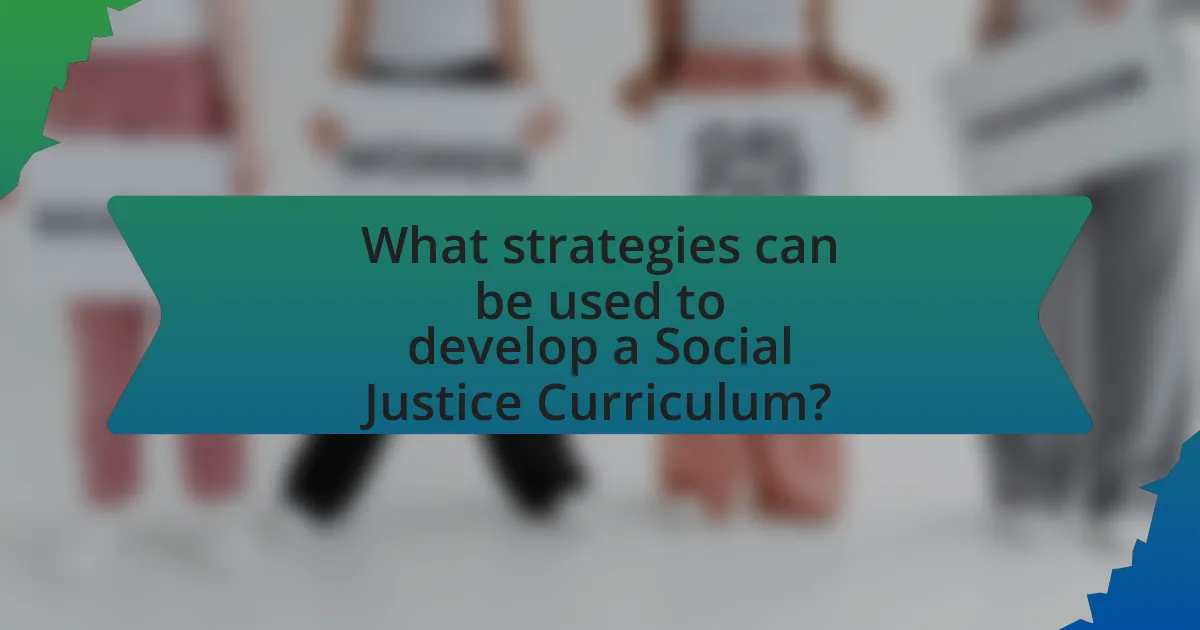
What strategies can be used to develop a Social Justice Curriculum?
To develop a Social Justice Curriculum, educators can implement strategies such as integrating diverse perspectives, fostering critical thinking, and promoting active engagement. Integrating diverse perspectives involves including voices and narratives from various cultural, racial, and socioeconomic backgrounds, which enriches students’ understanding of social issues. Fostering critical thinking encourages students to analyze and question societal norms and injustices, helping them to develop their own informed viewpoints. Promoting active engagement through community projects or discussions allows students to apply their learning in real-world contexts, reinforcing the relevance of social justice. Research indicates that curricula incorporating these strategies lead to increased student awareness and advocacy for social change, as evidenced by studies from the National Council for the Social Studies.
How can educators incorporate student voices in curriculum development?
Educators can incorporate student voices in curriculum development by actively engaging students in the decision-making process regarding what and how they learn. This can be achieved through methods such as surveys, focus groups, and student-led discussions, which allow students to express their interests, needs, and perspectives. Research indicates that when students are involved in curriculum design, their engagement and ownership of learning increase, leading to better educational outcomes. For instance, a study by the University of California found that schools that implemented student feedback mechanisms saw a 20% increase in student satisfaction and participation in class activities.
What methods can be used to gather student input?
Surveys and questionnaires are effective methods to gather student input. These tools allow educators to collect quantitative and qualitative data on students’ opinions, experiences, and suggestions regarding the curriculum. Research indicates that using anonymous surveys can increase response rates and honesty, as students may feel more comfortable sharing their thoughts without fear of judgment. Additionally, focus groups provide a platform for in-depth discussions, enabling students to express their views in a collaborative environment. According to a study published in the Journal of Educational Psychology, engaging students in discussions about their learning experiences leads to more relevant and impactful curriculum development.
How can student feedback shape curriculum content?
Student feedback can significantly shape curriculum content by providing insights into learners’ needs, preferences, and experiences. When educators collect and analyze feedback, they can identify gaps in knowledge, areas of interest, and the effectiveness of teaching methods. For instance, a study by the National Education Association found that incorporating student input leads to improved engagement and academic performance, as curricula become more relevant and responsive to student voices. This alignment fosters a more inclusive educational environment, particularly in social justice curricula, where understanding diverse perspectives is crucial.
What resources are available for educators creating a Social Justice Curriculum?
Educators creating a Social Justice Curriculum can access a variety of resources, including online platforms, academic journals, and community organizations. Notable online platforms such as Teaching Tolerance provide lesson plans and teaching strategies focused on social justice themes. Academic journals like the Journal of Social Justice Education offer peer-reviewed articles that explore effective practices and theoretical frameworks for social justice education. Additionally, organizations such as the Zinn Education Project supply resources and materials that emphasize the importance of teaching history from diverse perspectives. These resources collectively support educators in developing a comprehensive and impactful Social Justice Curriculum.
What types of literature and media can support the curriculum?
Literature and media that can support the curriculum include diverse books, articles, documentaries, films, and podcasts focused on social justice themes. These resources provide various perspectives and narratives that enhance understanding of social issues, historical contexts, and cultural experiences. For instance, books like “The Hate U Give” by Angie Thomas and documentaries such as “13th” by Ava DuVernay offer critical insights into systemic racism and inequality. Research indicates that incorporating diverse literature and media in education fosters empathy and critical thinking, essential components of a comprehensive social justice curriculum.
How can community partnerships enhance curriculum resources?
Community partnerships can enhance curriculum resources by providing real-world experiences and diverse perspectives that enrich educational content. These collaborations allow schools to integrate local knowledge, cultural insights, and practical applications into the curriculum, making learning more relevant and engaging for students. For instance, partnerships with local organizations can lead to service-learning projects that connect classroom concepts to community issues, fostering critical thinking and social responsibility. Research indicates that students involved in community-based learning demonstrate improved academic performance and greater civic engagement, highlighting the effectiveness of such partnerships in enhancing educational outcomes.
How can assessment be integrated into a Social Justice Curriculum?
Assessment can be integrated into a Social Justice Curriculum by employing formative and summative assessments that reflect students’ understanding of social justice concepts and their application in real-world contexts. For instance, educators can use project-based assessments where students analyze social issues, propose solutions, and reflect on their learning experiences. Research indicates that assessments aligned with social justice themes enhance critical thinking and engagement; a study by the National Education Association found that culturally relevant assessments improve student performance and motivation. Additionally, incorporating peer assessments fosters collaboration and allows students to evaluate diverse perspectives, further enriching their understanding of social justice.
What types of assessments are most effective for measuring social justice learning?
Formative assessments, such as reflective journals, peer assessments, and project-based evaluations, are most effective for measuring social justice learning. These types of assessments allow students to engage deeply with social justice concepts, reflect on their understanding, and apply their knowledge in real-world contexts. Research indicates that formative assessments enhance critical thinking and promote a deeper understanding of social justice issues, as they encourage ongoing dialogue and self-assessment among students (Black & Wiliam, 1998). Additionally, project-based assessments enable students to collaborate on social justice initiatives, fostering practical skills and community engagement, which are essential for understanding and addressing social inequalities.
How can educators ensure assessments are equitable and inclusive?
Educators can ensure assessments are equitable and inclusive by implementing diverse assessment methods that cater to various learning styles and backgrounds. This approach allows for a more accurate representation of student understanding and capabilities. Research indicates that using multiple assessment formats, such as projects, presentations, and traditional tests, can accommodate different strengths and reduce bias. For instance, a study by the National Center for Fair & Open Testing found that varied assessment types lead to improved student engagement and performance, particularly among marginalized groups. Additionally, incorporating student feedback in the assessment design process fosters a sense of ownership and relevance, further enhancing equity and inclusivity in educational assessments.
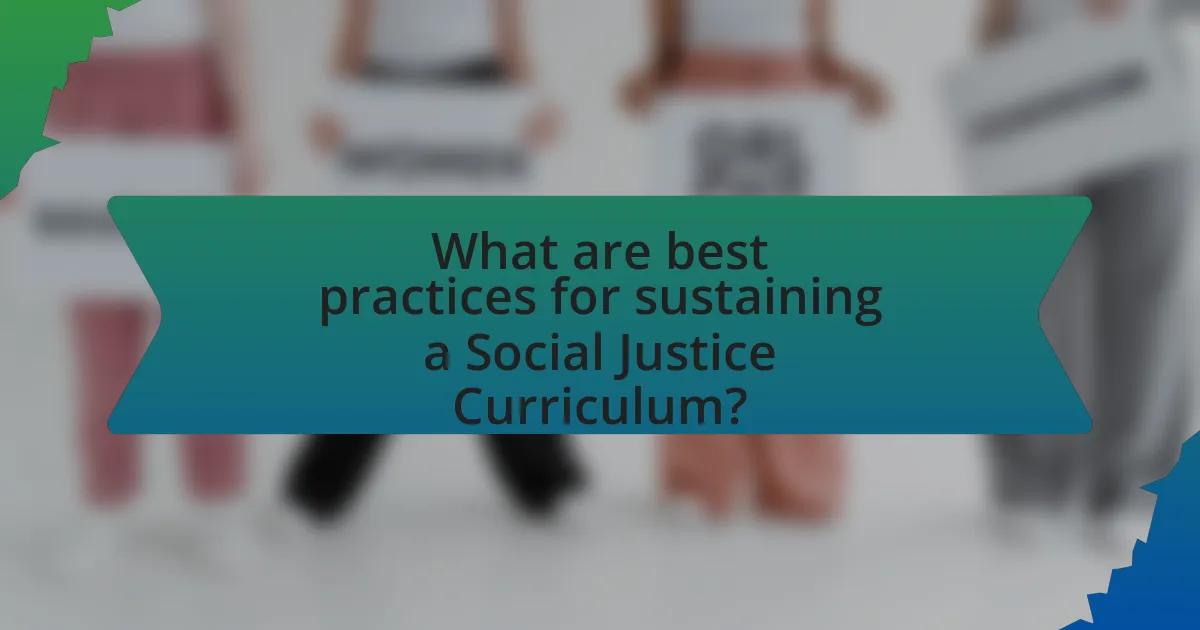
What are best practices for sustaining a Social Justice Curriculum?
Best practices for sustaining a Social Justice Curriculum include continuous professional development for educators, integrating student voices, and fostering community partnerships. Continuous professional development ensures that educators remain informed about social justice issues and pedagogical strategies, which is supported by research indicating that ongoing training enhances teaching effectiveness (Darling-Hammond et al., 2017). Integrating student voices allows for a curriculum that reflects diverse perspectives and experiences, promoting engagement and relevance. Fostering community partnerships connects schools with local organizations, enriching the curriculum with real-world applications and resources. These practices collectively create a dynamic and responsive Social Justice Curriculum that evolves with societal changes.
How can ongoing professional development support educators?
Ongoing professional development supports educators by enhancing their knowledge and skills, which directly improves their teaching effectiveness. Research indicates that teachers who engage in continuous learning are better equipped to implement innovative teaching strategies and adapt to diverse student needs. For instance, a study published in the “Journal of Teacher Education” found that professional development focused on social justice themes significantly increased teachers’ confidence and competence in addressing equity issues in the classroom. This ongoing training fosters a collaborative environment where educators can share best practices, ultimately leading to improved student outcomes and a more inclusive curriculum.
What training opportunities are available for teachers?
Training opportunities available for teachers include professional development workshops, online courses, and certification programs focused on social justice education. These programs often cover topics such as culturally responsive teaching, equity in the classroom, and inclusive curriculum design. For instance, organizations like the Teaching Tolerance project provide resources and training aimed at fostering social justice in education, equipping teachers with the necessary skills to create an inclusive learning environment. Additionally, universities and educational institutions frequently offer specialized courses that focus on social justice pedagogy, enhancing teachers’ understanding and implementation of these critical concepts in their classrooms.
How can collaboration among educators enhance curriculum sustainability?
Collaboration among educators enhances curriculum sustainability by fostering shared resources, diverse perspectives, and collective expertise. When educators work together, they can develop a curriculum that is more adaptable and responsive to changing societal needs, ensuring that it remains relevant over time. Research indicates that collaborative teaching practices lead to improved student outcomes, as seen in studies like “The Impact of Collaborative Professional Development on Teacher Practice” by P. Timperley et al., which highlights how joint efforts among teachers can lead to more effective instructional strategies. This collaborative approach not only strengthens the curriculum but also promotes a culture of continuous improvement and innovation in educational practices.
What role does community involvement play in sustaining the curriculum?
Community involvement is essential for sustaining the curriculum as it fosters collaboration between educational institutions and local stakeholders. This collaboration enhances the curriculum by integrating real-world perspectives, resources, and support from the community, which enriches the educational experience. For instance, research by the National Education Association indicates that schools with strong community partnerships see improved student engagement and achievement, demonstrating that active community participation directly contributes to the curriculum’s relevance and effectiveness.
How can schools engage families and local organizations in the curriculum?
Schools can engage families and local organizations in the curriculum by implementing collaborative projects that involve community input and participation. For instance, schools can host workshops where families and local organizations contribute their expertise to develop relevant curriculum content, ensuring that it reflects the community’s values and needs. Research indicates that when schools actively involve families, student achievement improves; a study by the Harvard Family Research Project found that family engagement in education leads to higher grades and test scores. Additionally, partnerships with local organizations can provide resources and real-world experiences that enhance learning, such as internships or service-learning opportunities, which further integrate social justice themes into the curriculum.
What strategies can be used to foster a culture of social justice in the community?
To foster a culture of social justice in the community, implementing educational programs that promote awareness and understanding of social issues is essential. These programs can include workshops, seminars, and community discussions that engage participants in critical conversations about inequality, discrimination, and systemic injustice. Research indicates that communities with active educational initiatives see increased civic engagement and advocacy for social change, as evidenced by the work of the American Psychological Association, which highlights the role of education in shaping social attitudes and behaviors. Additionally, forming partnerships with local organizations that focus on social justice can amplify efforts, providing resources and support for community-led initiatives.
What practical tips can educators follow when creating a Social Justice Curriculum?
Educators can enhance a Social Justice Curriculum by incorporating diverse perspectives, fostering critical thinking, and promoting active engagement. First, integrating materials from various cultures and communities ensures representation and relevance, which is essential for students to understand different social contexts. For instance, using literature from marginalized voices can provide insights into systemic inequalities. Second, encouraging critical thinking through discussions and debates allows students to analyze social issues deeply, fostering a more nuanced understanding of justice. Research indicates that students who engage in critical discourse are better equipped to challenge societal norms (Brookfield, 2012). Lastly, promoting active engagement through service-learning projects connects classroom learning to real-world applications, empowering students to take action in their communities. This hands-on approach not only reinforces theoretical knowledge but also cultivates a sense of responsibility and agency among students.

